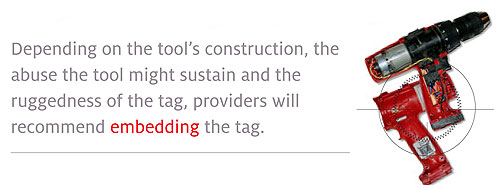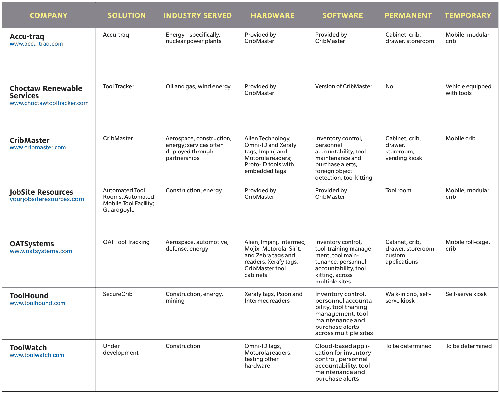Aug 01, 2012Most construction firms, energy and mining companies, and aerospace manufacturers have a common problem: The hand tools essential to their work tend to disappear from their plants and job sites. Whether tools are hoarded, mislaid or stolen, if the correct tool isn't in the right place when needed, it can delay or stop production. "Lost" tools that must be replaced have a negative impact on a company's or project's bottom line. And if a tool is accidentally left inside an engine or other piece of machinery, it could cause millions of dollars in damage or, worse, compromise safety.
The lost-tools problem has persisted despite the fact that tools are generally kept in secure cribs, managed by employees who record workers' names and the tools they check into and out of inventory. This manual process is slow, error-prone and labor-intensive. Some companies use bar-code technology in an attempt to automate their systems, but there are two major drawbacks: The bar codes on tools used in industrial environments are often too dirty to be scanned, and tools can't be located without a clear line of sight between the bar code and scanner.
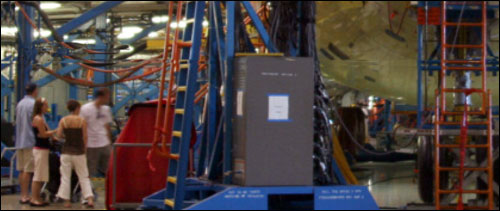
"Some of our first customers using RFID tool tracking were in the roofing industry," says Dean Perry, president of ToolHound, a provider of tool- and equipment-management systems. "Tar dirt covers the bar code on a tool, and it can no longer be read. With RFID, if the tool is covered with tar, it does not matter."
Tool-management vendors began testing and piloting passive and active (battery-powered) RFID tool-tracking systems in the mid-2000s. One of the main challenges at that time was that metal impairs read accuracy when using passive RFID tags, and many tools contain metal or are stored on metal shelves. The active systems delivered more reliable read rates, but the tags were expensive.
Several companies have worked with RFID vendors and systems integrators to develop tool-tracking systems. But there also are commercial solutions on the market that include the tags, cribs, readers and software needed to track and monitor tools at plants or job sites.
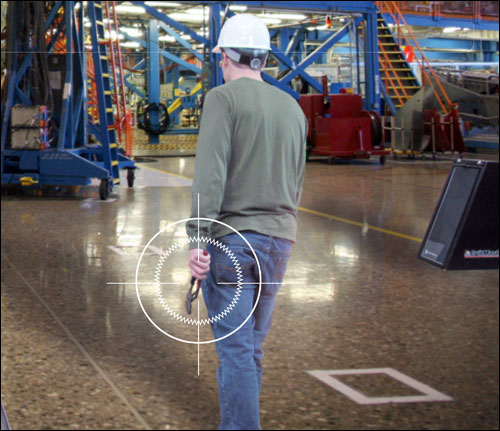
These packaged solutions can take from two weeks to four months to deploy, depending on how many tools you need to track, how many features you select, whether you require software customization or integration with legacy software, and whether you have staff members available to attach tags to existing tool stock. (Most providers will help end users attach tags to the tools.)
Accu-traq, Choctaw Renewable Services and JobSite Resources have strategic partnerships with CribMaster to leverage its RFID hardware and software platform for both permanent and short-term tool cribs. Each markets CribMaster's hardware to specific industries—renewable energy, large building construction, and conventional and nuclear energy generation, respectively. ToolHound and ToolWatch also offer complete RFID solutions. Here's what you need to know to determine whether a commercial tool-tracking solution might be right for your company.
Most tool-tracking providers offer a variety of on-site storage options to accommodate different sizes of tools. These can include cabinets, chests, kiosks, storerooms and vending machines.
Typically, the company issues workers RFID-enabled identification cards that they scan at a crib to access the tools. Readers identify the tools being removed, and inventory-control software records the information. With some solutions, such as ToolHound's Secure Crib Portal, workers use a touch screen computer to confirm the items being removed. Readers mounted near doorways or choke points can track the movements of tagged tools throughout a facility. A lost tool can be located quickly by setting a handheld reader to seek out the tag ID associated with the tool, then scanning a work area, using the reader as a sort of Geiger counter.
For short-term work, often involving multiple contractors, such as jobs at building construction sites, tool-management services generally set up secure, mobile tool cribs. These cribs are typically modular and, therefore, highly configurable. The providers say they will help you evaluate your needs, then set up portal readers, antennas and other hardware. You can decide whether you want a temporary crib staffed by the service provider, staffed by your employees or unstaffed.
JobSite Resources, for example, once set up a temporary crib at a construction site that linked three 20-foot shipping containers filled with RFID-tagged tools. Because the crib was so large, assistants helped workers locate the tools they needed.
Most tags are attached to the exterior of hand tools. But in some cases—depending on the tool's construction, the abuse the tool might sustain and the ruggedness of the tag—providers will recommend embedding the tag. With handheld power drills or sanders, for example, they will open up the tool's plastic casing and embed the tag inside. Either way, they will work with you to ensure the tags are reliable and readable at the distances and speeds your use cases dictate.
If you need to replace hand tools or add more to your inventory, the Proto-ID tools from Stanley Black & Decker come with embedded EPC Gen 2 tags, which can be used with the tool-tracking solution from CribMaster, acquired last year by Stanley Black & Decker. The tools are paired with foam liners inside tool drawers that are wired to an embedded reader in the tool chest or larger cabinet. Each tool has a designated home, matched exactly to the tool's size and profile, inside a drawer. When the tool is removed from its location, the RFID reader instantly recognizes the change and updates the tool inventory.
Software is the key to automation for tracking hand tools. It controls which employees are granted access to unstaffed tool cribs, continuously updates tool inventory records and enables other benefits.
Service providers that previously offered bar-code tool-tracking systems have modified their software platforms to accommodate RFID tag data and tie tools' unique identifiers to employees' badge numbers. This way, if a worker does not return a tool at the end of a shift, management will know to whom that tool was issued and can start tracking it down.
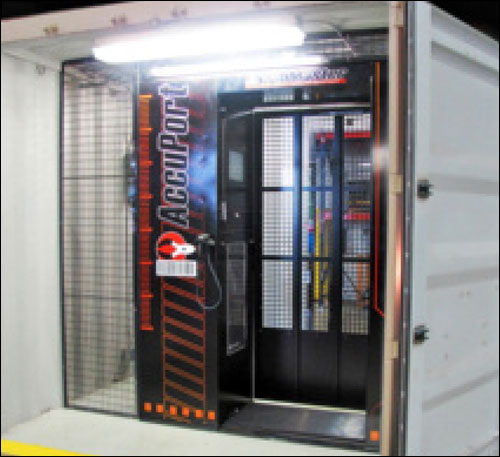
In addition to using the software for inventory management, you can use it to track each tagged tool through its life cycle. The software will alert tool crib managers when specific tools are due for recalibration and other scheduled maintenance, for example.
To use certain tools, employees require special training. Software can verify that the employee checking a specific tool out of a crib has been trained in how to use the tool and is authorized to take it. If it detects an employee taking a tool that the individual is not certified to use, the software will send an alert to the crib manager.
In the aerospace and energy industries, tool tracking is not just a matter of inventory management—it's essential for safety. If, for example, a tool were inadvertently left inside an engine, it could cause significant damage. Most companies require safety checks as part of foreign object detection or foreign material exclusion programs. But these are often manual processes, which are error-prone.
RFID automates safety checks, making tracking RFID-tagged tools easy and reliable. After a mechanic completes a repair job on an engine, for example, a handheld RFID reader can be used to confirm that all the tools brought to a job site are accounted for. Lockheed Martin uses an RFID tool-tracking solution from CribMaster at five manufacturing sites to monitor when a particular tool was used and by whom—and to ensure tools aren't left inside a plane during assembly.
The Donald C. Cook nuclear power plant, in Bridgman, Mich., uses an RFID tool-management solution from Accu-traq to monitor tagged hand tools, safety rigging and fire extinguishers. Plant employees use handheld RFID readers to perform fast, accurate inventory audits and to locate equipment that is missing or due for maintenance. The main tool crib still requires a manual checkout process, says Mike Frazier, Cook's tool crib supervisor, but the plant plans to transition to an automated system, in which employees will use RFID-tagged badges to access the crib.
The plant also plans to invest in CribMaster's mobile RFID tool chests, to monitor and account for all tools brought to work areas. This will ensure compliance with the plant's foreign material exclusion program. "Say you open up a turbine [for maintenance]," Frazier says. "You need to document that every tool that enters that area also exits it."
Some nuclear power plant customers maintain two separate RFID tool cribs, one of which is inside "hot" areas of the plant, says ToolHound's Perry. That's because tools exposed to radiation must remain in those hot areas. RFID readers mounted at portals can alert staff members if a hot tool is about to be brought out into noncontaminated parts of the plant.
"For us, adoption of RFID-based tool tracking is still very slow—probably less than 5 percent of our customer base," Perry says. Cost is the main issue, he adds. Putting a bar-code label on a tool costs a few cents, but rugged RFID tags, specialized for metal mounts, can cost $3 to $5 each, he says. Plus, the RFID reader adds around $1,500 to the cost of a $2,400 handheld computer. But lost tools exact a toll on a company's bottom line, and he expects that as tag costs continue to fall, more companies will turn to RFID solutions.
"Large construction firms used to view tools as a necessary evil," says Mike Green, president of JobSite Resources. "Their margins were great, and they could throw more money at tools when they were lost. Now, margins are tight, so construction firms are looking to better manage their assets. Just in the past 18 months, we've seen a huge increase in the number of inquiries and prospects from the construction industry. With a lot of reductions in manpower, they can't have a manual process for tool check-in and check-out, so now they're looking toward [RFID] technology to improve the process."
To view a larger version of the above table, click here.
JobSite's tool-management service has helped customers reduce tool costs by up to 50 percent during construction projects, Green says. "Single, short-term projects can generate tens of thousands of dollars in lost tools. But large companies will have six or seven of these jobs going on simultaneously. So across an entire year, RFID-based tracking could save these firms "hundreds of thousands of dollars," he says.
At ToolWatch, the current transition to offering RFID-based tool tracking is part of a larger movement toward enabling "machine-to-machine transactions" that remove humans from the equation, says Jason Watts, the company's senior programmer. Tools will be tracked around a job site, or between job sites, and the inventory-management software will be updated constantly and seamlessly.
For companies that are still tracking tools manually or with bar codes, the steps are tedious and slow, and any human error along the chain can lead to a tool's disappearance. With RFID automated tracking, Watts says, "It's still a really important part of [the workers'] day—but they won't have to think about it."
Some companies, such as those listed below, have developed in-house systems for improving visibility of and control over hand tools. Organizations have different reasons for electing to develop their own solutions. In some cases, the tools to be tracked require specialized tags, or the organization wants to customize an element of the tracking system and scale multiple locations.
Grunnarbeid Begins Full-scale Rollout of Tool-Tracking System
After testing the use of EPC Gen 2 passive RFID tags to track tools as they enter and leave containers and vehicles, the central Norwegian construction company is installing the solution across all its operations.
Naval Surface Warfare Center Demos RFID Tool-Tracking Solution for Combat Ships
The system uses EPC Gen 2 UHF tags and readers to identify items loaded on board, in cabinets stored within steel containers, enabling the U.S. Navy to reduce inventory-tracking time from 32 hours to two minutes.
RFID Helps U.K. Tool Rental Company Better Serve Customers
Speedy Services' on-site solution provides continuous access to equipment, to meet work-crew schedules.
ThyssenKrupp Steel Europe Tracks Its Tools
The German company is employing passive HF RFID tags and readers to monitor the usage, maintenance and inspection of nearly 500 tools used at a ThyssenKrupp Electrical Steel plant.

